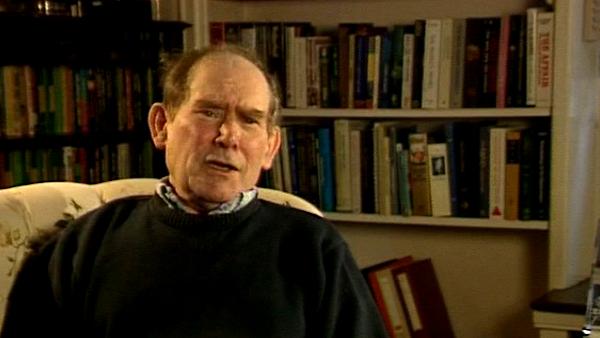NEXT STORY

Issues of the organisation of DNA replication in a bacterial cell
RELATED STORIES

NEXT STORY

Issues of the organisation of DNA replication in a bacterial cell
RELATED STORIES


|
Views | Duration | |
|---|---|---|---|
| 111. A completely interlocking theory | 212 | 01:24 | |
| 112. Lab space | 276 | 01:37 | |
| 113. Experimenting with adding messengers to ribosomes | 216 | 03:55 | |
| 114. The state of biochemistry in Britain | 258 | 02:54 | |
| 115. 1962: a new lab and a new way of working | 249 | 01:04 | |
| 116. The importance of understanding molecular structure (Part 1) | 263 | 03:01 | |
| 117. The importance of understanding molecular structure (Part 2) | 236 | 04:36 | |
| 118. Looking for a new subject and inventing names | 239 | 04:16 | |
| 119. DNA replication | 235 | 02:39 | |
| 120. DNA replication: the first experiment | 226 | 04:23 |


Our very first one was very simple. Bacteria had elements called F elements. These F elements could transfer themselves by so-called process of conjugation from one bacterium to another. That was work that had done by Bill Hayes and of course extensively by Jacob and Wollman in their study of bacterial conjugation, and they proved that the chromosome – when it was attached to an F element in the so-called Hfr strains, high frequency of recombination – were transferred from one point in one given direction, and progressively, so that it would take about two hours, 120 minutes, to transfer the whole chromosome. And we thought that the good driving force for this – this was the replicon idea – was of course replication itself. So our idea was that a bacterial cell carrying an F element had two replicons: its own and one of the F element. The F element was a rather special one in that it started from a point of origin and then by replication it would drive the chromosome across the cell, because you can either think of the DNA polymerase sitting in one place... you can either think of the DNA polymerase moving along the DNA, but if you were to nail it down what would happen is the DNA would pass through it. Which is of course a much better picture of what's going on. And if it did this it would transfer a daughter chromosome. Now, what we knew is that acridine orange cured F factors. That is, if you grew cells carrying F factors in acridine orange they lost them. We therefore argued for some reason or another the F factor was sensitive, its replication was sensitive to this dye, acridine orange. Therefore, we said, if transfer was due to the same replication experiment we should be able to stop transfer by acridine orange. However, there was no sign that acridine orange actually inhibited replication, and so our argument was that once it got started you couldn't stop it with acridine orange. You could only stop its initiation. And of course we did the experiments, they were very simple to do and they worked immediately. Well, François and I discussed this is the… in spring of 1962, we discussed this at a meeting at Royaumont and we both went home and we both did the experiment the next day and we phoned each other up to tell us, to tell each other that we'd got the same results. So we then proceeded to do more experiments, and in fact we planned a rather complicated experiment and… but decided that since the theory was so good we would write it up in advance. And we went on a combined family holiday to a French seaside resort called La Tranche which we used to… we still do refer to as Zee Slice, in the Vendée, and we spent hours on the beach sort of telling children not to pester us, and in that we developed the whole idea of the replicon. Which we published later that year in the Comptes Rendus and that was the theory of… and we proceeded then to do a number of experiments to test it.
South African Sydney Brenner (1927-2019) was awarded the Nobel Prize in Physiology or Medicine in 2002. His joint discovery of messenger RNA, and, in more recent years, his development of gene cloning, sequencing and manipulation techniques along with his work for the Human Genome Project have led to his standing as a pioneer in the field of genetics and molecular biology.
Title: DNA replication: the first experiment
Listeners: Lewis Wolpert
Lewis Wolpert is Professor of Biology as Applied to Medicine in the Department of Anatomy and Developmental Biology of University College, London. His research interests are in the mechanisms involved in the development of the embryo. He was originally trained as a civil engineer in South Africa but changed to research in cell biology at King's College, London in 1955. He was made a Fellow of the Royal Society in 1980 and awarded the CBE in 1990. He was made a Fellow of the Royal Society of Literature in 1999. He has presented science on both radio and TV and for five years was Chairman of the Committee for the Public Understanding of Science.
Tags: 1962, Fondation Royaumont, La Tranche sur Mer, Vendée, Comptes Rendus, William Hayes, François Jacob, Elie Wollman
Duration: 4 minutes, 24 seconds
Date story recorded: April-May 1994
Date story went live: 24 January 2008